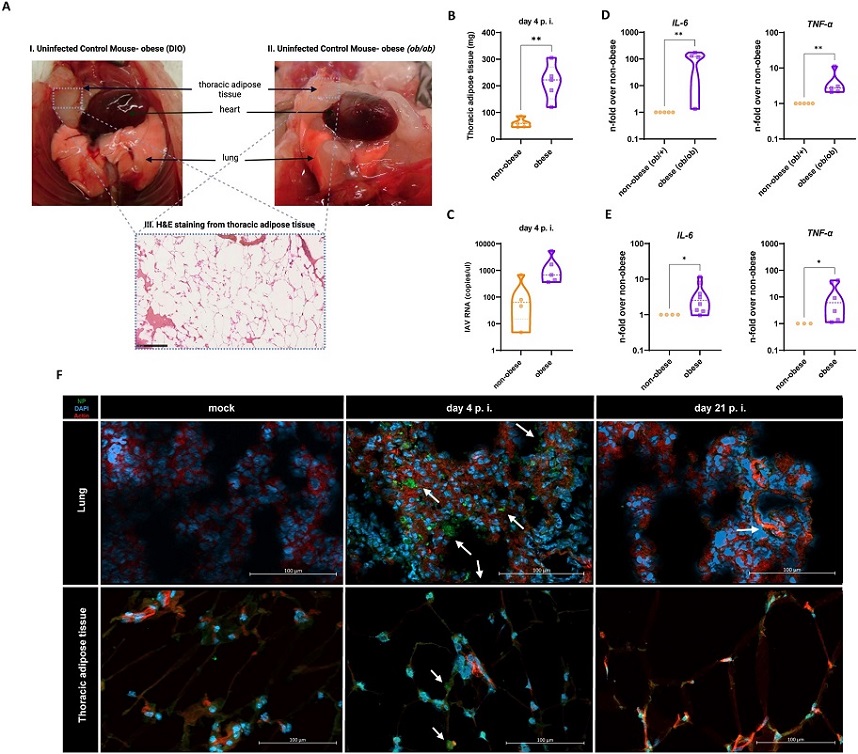German Study Shows That Thoracic Adipose Tissue Contributes To Severe Virus Infection Of The Lung In Both Influenza And COVID-19 Context
Thailand Medical News Team Aug 18, 2023 2 years, 4 months, 2 weeks, 6 days, 9 hours, 54 minutes ago
COVID-19 News: The connection between obesity and the severity of respiratory infections has come into sharp focus, with influenza and COVID-19 demonstrating this association. Researchers at Jena University Hospital in Germany undertook a pioneering study to investigate the intricate relationship between adipose tissue and respiratory pathogens, aiming to elucidate the mechanisms underlying this connection. Their work sheds light on the role of adipose tissue in viral infections and underscores the potential implications for public health.
 Thoracic adipose tissue adjacent to the lungs harbored influenza virus.
Thoracic adipose tissue adjacent to the lungs harbored influenza virus.
A) Image of the thorax lumen of uninfected DIO (left) and ob/ob mice (right) with H&E staining of a representative cryosection (4 µm thickness) of the extracted thoracic adipose tissue, Scale bar, 250 μm. B, C ob/ob (n = 5) mice showed increased thoracic adipose tissue mass (B) and elevated copies/mg of IAV within the extracted tissue day 4 p.i. compared to non-obese (n = 5). Extracted abdominal adipose tissue sections from obese ob/ob (D) and DIO mice (E) show upregulated mRNA levels of IL-6 and TNF-α compared to the corresponding non-obese mice. F IAV nucleoprotein (green) visualized by immunofluorescence staining detected at day 4 p.i. (arrowhead) within cryosections (4 µm) from lung and additionally extracted thoracic adipose tissue from representative ob/ob mice. Phalloidin (red) and DAPI (blue) staining were used to detect actin and the nuclei. Scale bar 100 μm. P calculated by Mann-Whitney-test (B, D, E). *P < 0.05**P < 0.01.
Obesity's Impact on Respiratory Infections
Obesity has emerged as an independent risk factor for severe respiratory infections, including influenza and COVID-19 as covered in previous studies and
COVID-19 News reports. This heightened susceptibility to viral infections has sparked curiosity regarding the interaction between adipose tissue and respiratory pathogens, yet the underlying mechanism remains largely unexplored.
Adipose tissue is more than just an energy reservoir; it functions as an endocrine gland, secreting proinflammatory factors that contribute to low-grade inflammation. These factors, in turn, have been hypothesized to indirectly facilitate virus infections by creating a favorable environment. However, the direct potential of adipose tissue to harbor and support viral replication has remained a scientific enigma.
Unraveling the Mysteries
The research at Jena University Hospital delved deep into the interaction between obesity, adipose tissue, and viral respiratory infections. The objective was to elucidate the mechanisms driving the increased severity of infections in obese individuals. Two distinct murine obesity models were employed: diet-induced obesity (DIO) and the ob/ob model. These models were subsequently infected with influenza A virus (IAV), with the resulting infection monitored over a period of three weeks. The viral load in the lung
and adipose tissue was meticulously analyzed to unravel the connections between adipose tissue and viral infections.
Surprising Findings in Murine Models
The results were striking. Both obesity models displayed notably higher IAV titers compared to their non-obese counterparts. Intriguingly, adipose tissue located adjacent to the lungs emerged as a focal point for IAV replication in these obese mice. This observation pointed to a previously undiscovered avenue for viral replication. The study also reported successful IAV replication and an antiviral response within human adipocytes, demonstrating the potential for viruses to directly replicate within adipose tissue.
Indirect Inflammatory Impact
A pivotal aspect of this research was the examination of the indirect influence of adipocyte secretory products during infection. To do this, a co-culture system was developed, involving lung fibroblasts and adipocytes. The results revealed an increase in IL-8 concentration during infection, suggesting that adipocytes could indeed contribute to the inflammatory response observed during respiratory infections. This finding further underscores the intricate relationship between adipose tissue and viral infections.
Insights from COVID-19 Patients
To broaden the scope of their investigation, the researchers turned to examining lung and adipose tissue from deceased patients infected with the SARS-CoV-2 omicron variant. While active SARS-CoV-2 replication wasn't observed in adipocytes in vitro, the virus was detected in macrophages, indicating that these immune cells might be implicated in viral replication and subsequent inflammation. This discovery contributes to our understanding of how SARS-CoV-2 behaves within the body and how it interacts with different cell types.
Implications and Future Research
The implications of this study are significant. The research reveals that thoracic adipose tissue, particularly in obese individuals, is not only an indirect contributor to virus infections through inflammation but can also function as a direct viral niche. The close proximity of adipose tissue to the lungs might provide an environment conducive to viral replication, potentially explaining the heightened severity of infections in obese individuals. These findings offer new insights into the mechanisms that drive severe respiratory infections and suggest novel avenues for therapeutic interventions.
Conclusion
In conclusion, the research conducted at Jena University Hospital has illuminated the complex interplay between adipose tissue and severe respiratory infections.
The study demonstrates that adipose tissue can play a pivotal role in the direct replication of viruses, shedding light on the factors underlying the increased vulnerability of obese individuals to respiratory infections. By unraveling these mechanisms, the research contributes not only to our understanding of viral pathogenesis but also provides potential targets for therapeutic strategies. As the global health landscape continues to be shaped by emerging respiratory viruses, this study's findings hold promise for improved treatment approaches and enhanced preparedness in the face of future outbreaks.
The study findings were published in the peer reviewed International Journal of Obesity.
https://www.nature.com/articles/s41366-023-01362-w
For the latest
COVID-19 News, keep on logging to Thailand Medical News.
 Thoracic adipose tissue adjacent to the lungs harbored influenza virus.
Thoracic adipose tissue adjacent to the lungs harbored influenza virus.